Physical Address
304 North Cardinal St.
Dorchester Center, MA 02124
Knowledge of the normal physiologic transition from fetal to neonatal life and potential disruptions of this process is vital to a comprehensive understanding of neonatal resuscitation.
Preparation of personnel and equipment prior to resuscitation is essential.
The first steps in resuscitation include stimulating the infant, maintaining a normal body temperature through management of heat gain and loss, and assessment of breathing and heart rate.
Infants who do not establish adequate respirations following the initial resuscitative steps are in secondary apnea. These infants will require respiratory support with positive pressure ventilation.
The adequacy of positive pressure ventilation should be assessed by change in heart rate and chest rise. Ventilation corrective steps should be performed if needed.
Chest compressions are started when the heart rate is below 60 beats per minute despite effective ventilation for 30 seconds and are performed using a 3:1 compression to ventilation ratio. Newborn infants who receive chest compressions have a high incidence of mortality and short-term neurologic morbidity.
Epinephrine should be given to infants who have a heart rate less than 60 beats per minute despite adequate ventilation and chest compressions for 30 seconds. Epinephrine is more effective when given via the intravenous route versus the endotracheal route.
Volume resuscitation is potentially lifesaving in the setting of hypovolemic shock, acute blood loss, or sepsis.
The choice to withhold aggressive resuscitation in the delivery room involves complex ethical considerations and should result from a collaborative decision involving both healthcare providers and parents.
Most babies successfully transition from fetal to neonatal life without any support. Approximately 15% will require some type of resuscitation, although only 5% will require resuscitation beyond drying and stimulation. These percentages may seem small, but with an estimated 3.8 million births in the United States in 2017 and 136 million worldwide, there are 190,000 babies in the United States and 6.8 million worldwide each year who require resuscitative measures beyond the initial basic steps.
Birth attendants with neonatal resuscitation training can decrease neonatal mortality. , Two of the most common neonatal resuscitation training programs are the Neonatal Resuscitation Program (NRP) and Helping Babies Breathe, both from the American Academy of Pediatrics. However, although these programs are a good start, being truly prepared for resuscitation necessitates regular practice of skills. Neonatal death rates are higher at hospitals with a lower number of annual births. A study of rural hospitals revealed that many providers had not performed neonatal resuscitation in the past year. There was also a correlation between frequency of skill performance and comfort level.
Additionally, it is helpful to be aware of the physiology of neonatal transition, resuscitation, and postresuscitation care. This knowledge is particularly important during complex resuscitation when the newborn is not improving after standard resuscitative actions.
The essential step during transition from fetal to neonatal life is ventilation to establish the lungs as the site of gas exchange. In utero, the fetus receives oxygen and nutrients from the placenta through the umbilical vein. The oxygenated blood traverses the ductus venosus, right atrium, patent foramen ovale, left atrium, left ventricle, and aorta to the carotid and coronary arteries supplying the brain and heart. Some of the less oxygenated blood returning to the heart from the superior and inferior vena cava goes to the pulmonary circulation, but most crosses the ductus arteriosus and goes to the lower body and back to the placenta ( Fig. 8.1A ).
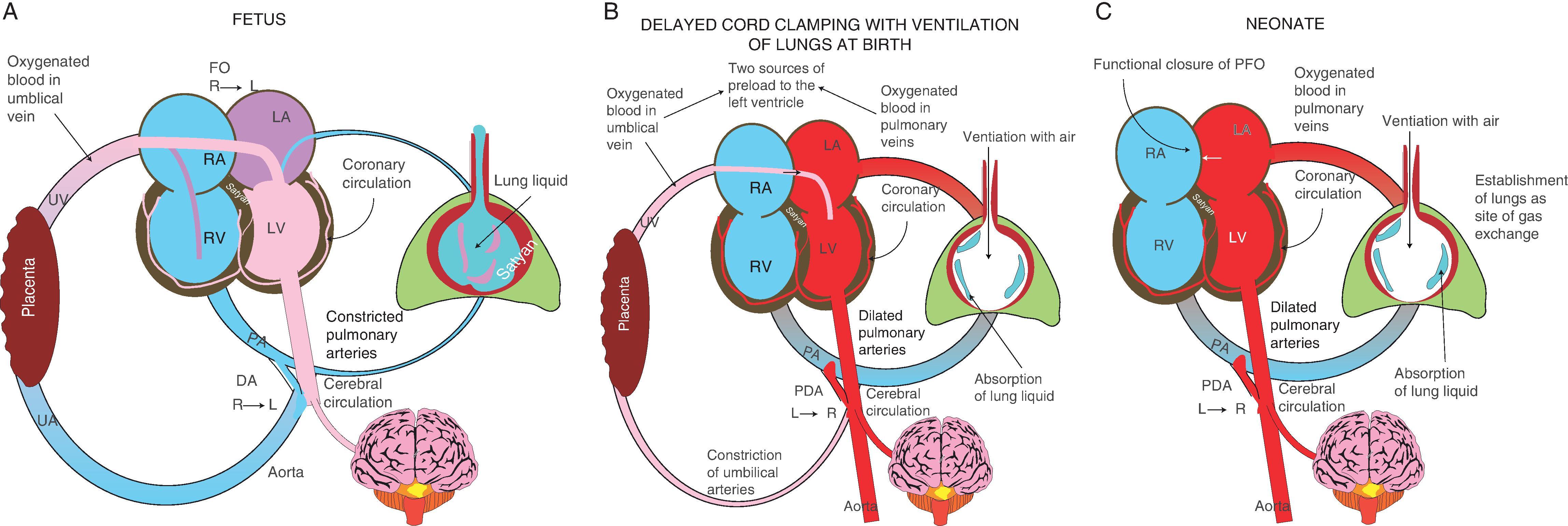
At the time of birth, the infant initiates breathing and aerates its lungs because the lungs must now be the site of gas exchange, rather than the placenta. The transition from fluid-filled to air-filled airways is mediated both by active sodium absorption by the respiratory epithelium and the increase in airway pressure that occurs with the onset of breathing. Air replaces fluid, the lung becomes inflated, and the functional residual capacity (FRC), with air and an air–fluid interphase, is created. This, along with the increase in oxygenation that accompanies adequate ventilation, causes a significant decline in pulmonary vascular resistance. If umbilical cord clamping is delayed past ventilation of the lungs, two sources of oxygenated blood (the umbilical vein and pulmonary veins) contribute to left ventricular preload (see Fig. 8.1B ). Subsequently the umbilical cord is clamped and blood stops flowing to the low-resistance placenta, causing an increase in systemic vascular resistance. The pressure in the left atrium then exceeds that of the right owing to both the increased systemic vascular resistance and the increase blood return to the left atrium, which leads to the functional closure of the foramen ovale (see Fig. 8.1C ). The elevated left-sided pressure also causes the flow from right to left across the ductus arteriosus to switch to left to right. The increase in oxygenation causes closure of this shunt during the first days of life in term infants.
This process of neonatal transition can be disrupted by alteration of placental blood flow to the fetus or due to neonatal factors impairing the establishment of pulmonary gas exchange, such as impaired ventilation, airway anomalies, birth asphyxia, or parenchymal lung disease (respiratory distress syndrome [RDS] or meconium aspiration syndrome). The term asphyxia describes this lack of sufficient gas exchange resulting in hypoxemia, hypercapnia, and acidosis. The fetus first attempts to redistribute blood flow to vital organs including the brain and heart. However, prolonged asphyxia leads to severe injury to these organs, causing hypoxic-ischemic encephalopathy (HIE).
Asphyxia causes distinctive patterns of breathing and hemodynamic changes. Geoffrey Dawes first described these patterns in 1968 based on his animal model of asphyxia. A similar phenomenon has been described in infants. After a period of acidosis, there is an initial attempt to recover with respiratory efforts to improve gas exchange followed by a period of primary apnea. During primary apnea, bradycardia is observed with preservation of blood pressure by several compensatory mechanisms. Stimulation during this time could result in recovery of normal respirations. As asphyxia progresses without stimulation and recovery, gasping respirations develop, followed by a period of secondary apnea. During secondary apnea, blood pressure drops, resulting in myocardial dysfunction. During this period, positive pressure ventilation (PPV) is required for resuscitation, and stimulation alone is not adequate ( Fig. 8.2 ).
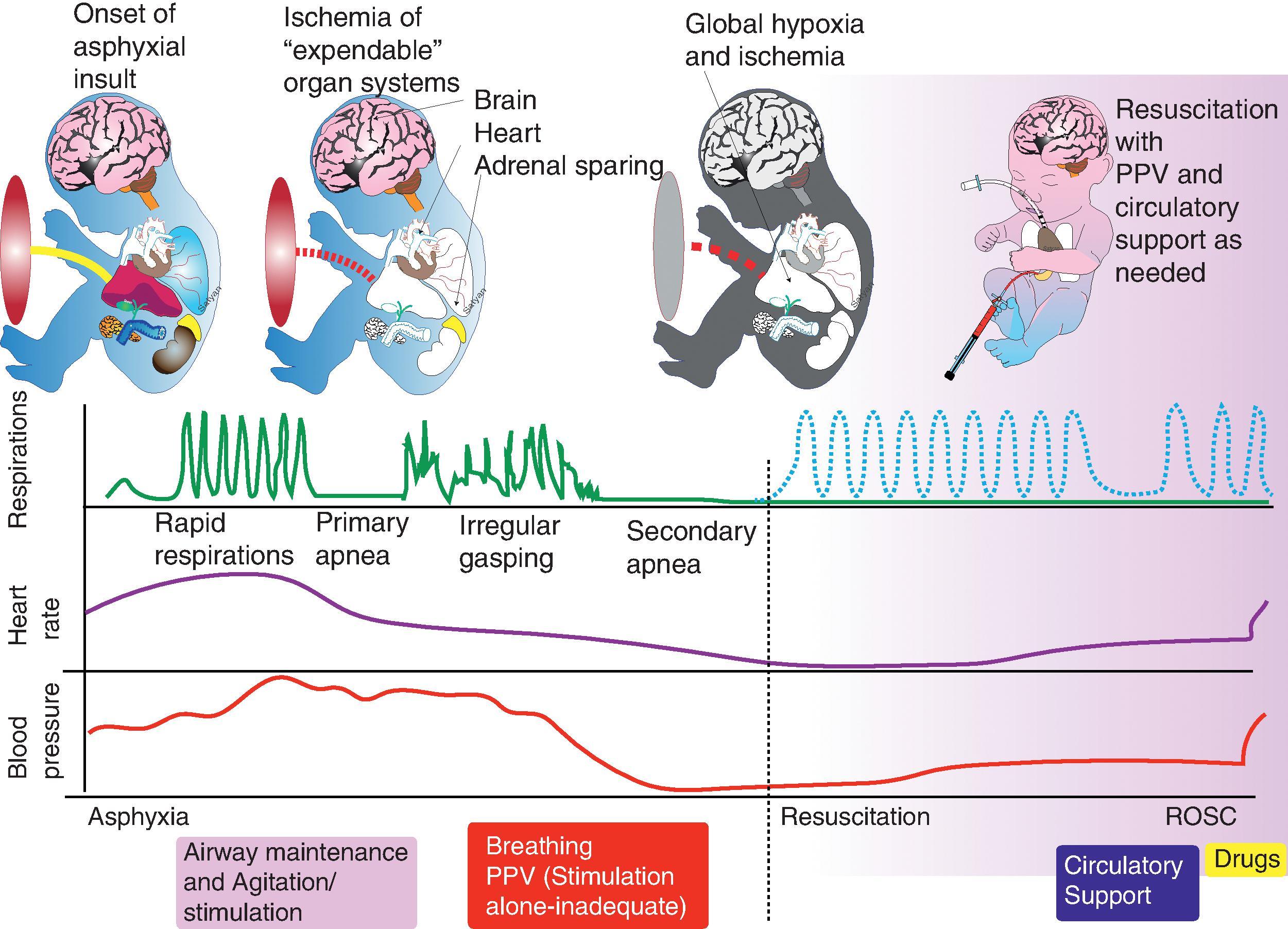
In addition, asphyxia can modify the circulatory changes that occur at the time of birth. Hypoxia and acidosis inhibit the normal decrease in pulmonary vascular constriction and closure of the ductus arteriosus, so right-to-left blood flow continues. There may also be persistence of the right-to-left flow through the foramen ovale due to pulmonary hypertension that causes increased right atrial pressure.
Prompt resuscitation may be able to reverse these alterations, especially if the period of asphyxia was recent and brief. The subsequent portions of this chapter will discuss how to prepare and carry out newborn resuscitation.
The most important part of a successful resuscitation is what happens prior to delivery. Five questions ( Table 8.1 ) with the pneumonic GRASP should be communicated between obstetric and pediatric providers. The team should be informed about gestational age, possible risk factors (such as diabetes, hypertension, and history of prior pregnancy or delivery problems), color of the amniotic fluid, number of fetuses, and plans for placental transfusion. The neonatal providers must have the appropriate resuscitation skills, and all resuscitation equipment should be functional and located nearby. Although risk factors are present in many babies requiring extensive resuscitation, the need for resuscitation can also be a surprise. It is thus important to be prepared at every delivery.
| Gestational age—What is the expected gestational age? |
| Risk factors—Are there any additional risk factors? |
| Amniotic fluid—Is the amniotic fluid clear? |
| Single/multiple—How many babies are expected? |
| Placental transfusion—Are there any plans for delayed cord clamping or cord milking? |
It is essential that the teams responsible for neonatal resuscitation are able to expertly perform their respective tasks and communicate effectively. In a review of 47 cases of perinatal death or permanent disability reported to the Joint Commission under the Sentinel Event Policy, communication, staff competency, and training were identified as the top root causes. The traditional method of neonatal resuscitation certification is the NRP from the American Academy of Pediatrics, which requires providers to complete training every 2 years. However, this program does not ensure competence. The most recent International Liaison Committee on Resuscitation consensus statement that addresses timing for advanced resuscitation retraining presents evidence that there is a decay in skills and knowledge within months after initial training. This statement also states that more frequent training is needed, although the optimal frequency and method of training remain undetermined. Personnel should also be capable of working together as a team. The use of interdisciplinary simulation including mock code drills on a continual basis helps to maintain skills and develop coordination among staff.
One individual whose sole responsibility is the infant and who is capable of initiating resuscitation should attend every delivery. They or another person in the immediate vicinity should be capable of the complete process of neonatal resuscitation. If there are risk factors, at least two people should be at the delivery and prepared to resuscitate the infant. A team briefing should occur prior to the delivery during which the leader is identified, roles of each member are assigned, equipment is checked, and anticipated resuscitation needs are discussed.
Resuscitation equipment should be checked on a regular basis and just prior to each delivery for both availability and function. A standardized equipment checklist can be helpful, and an example of this is provided in the NRP textbook.
An initial assessment of the infant should be made upon delivery. The infant can stay with the mother for the resuscitation if he or she appears to be of term gestation, has good tone, and is breathing or crying ( Fig. 8.3 ).
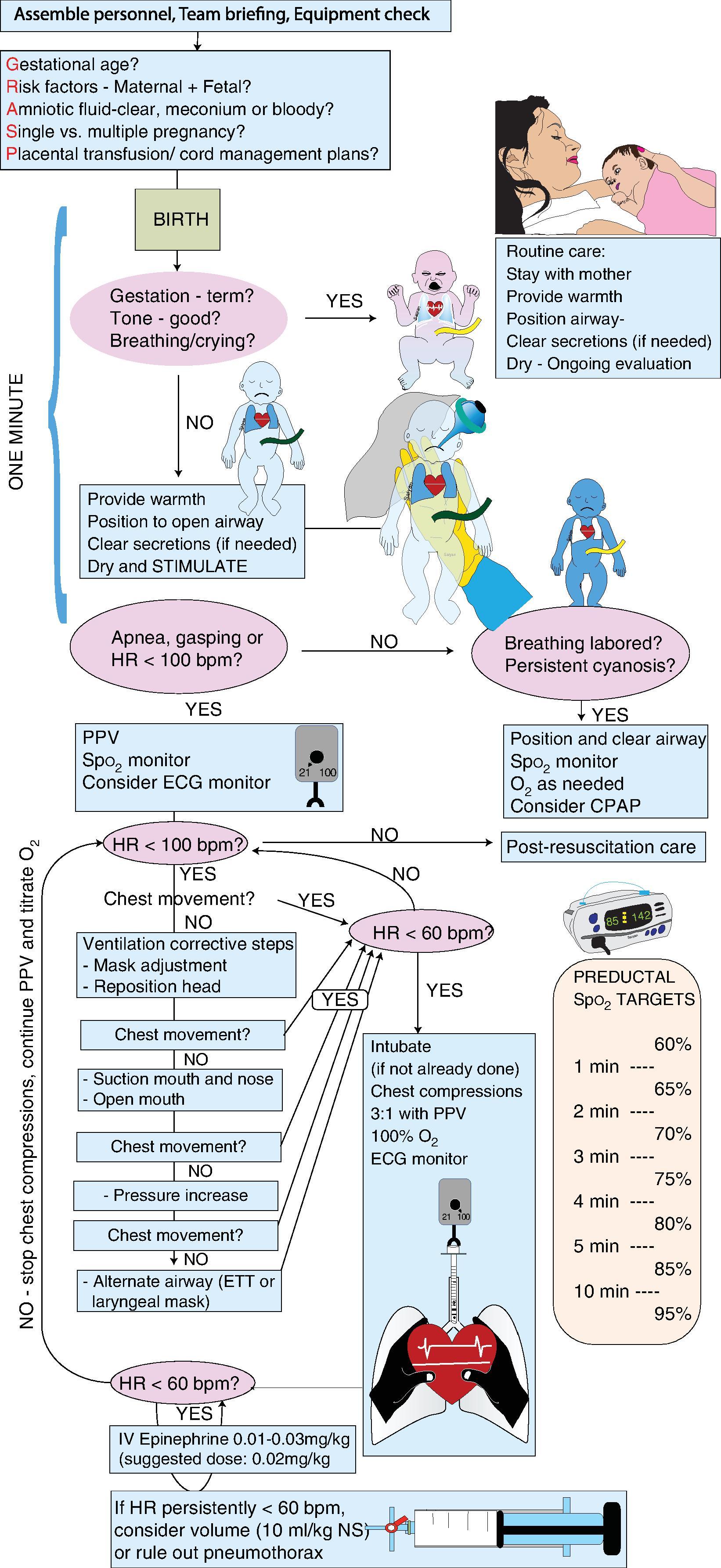
After the infant is born, the infant should be dried (or if premature, the infant’s body should be placed in a plastic bag or wrap) to prevent evaporative heat loss. Drying also provides stimulation and is often sufficient for an infant that is in primary apnea to begin breathing. Additional stimulation by flicking the soles of the feet and rubbing the back can also be provided. Warmth should be provided by placing vigorous babies skin to skin with their mother or moving them to a radiant warmer.
Term infants should be placed skin to skin after delivery, if they meet the criteria above or in a radiant warmer to avoid excessive heat loss. They should be dried and the wet blankets should be removed to prevent evaporative heat loss. The temperature of nonasphyxiated infants should be measured and be kept between 36.5°C and 37.5°C because both hypothermia and hyperthermia are associated with increased morbidity and mortality.
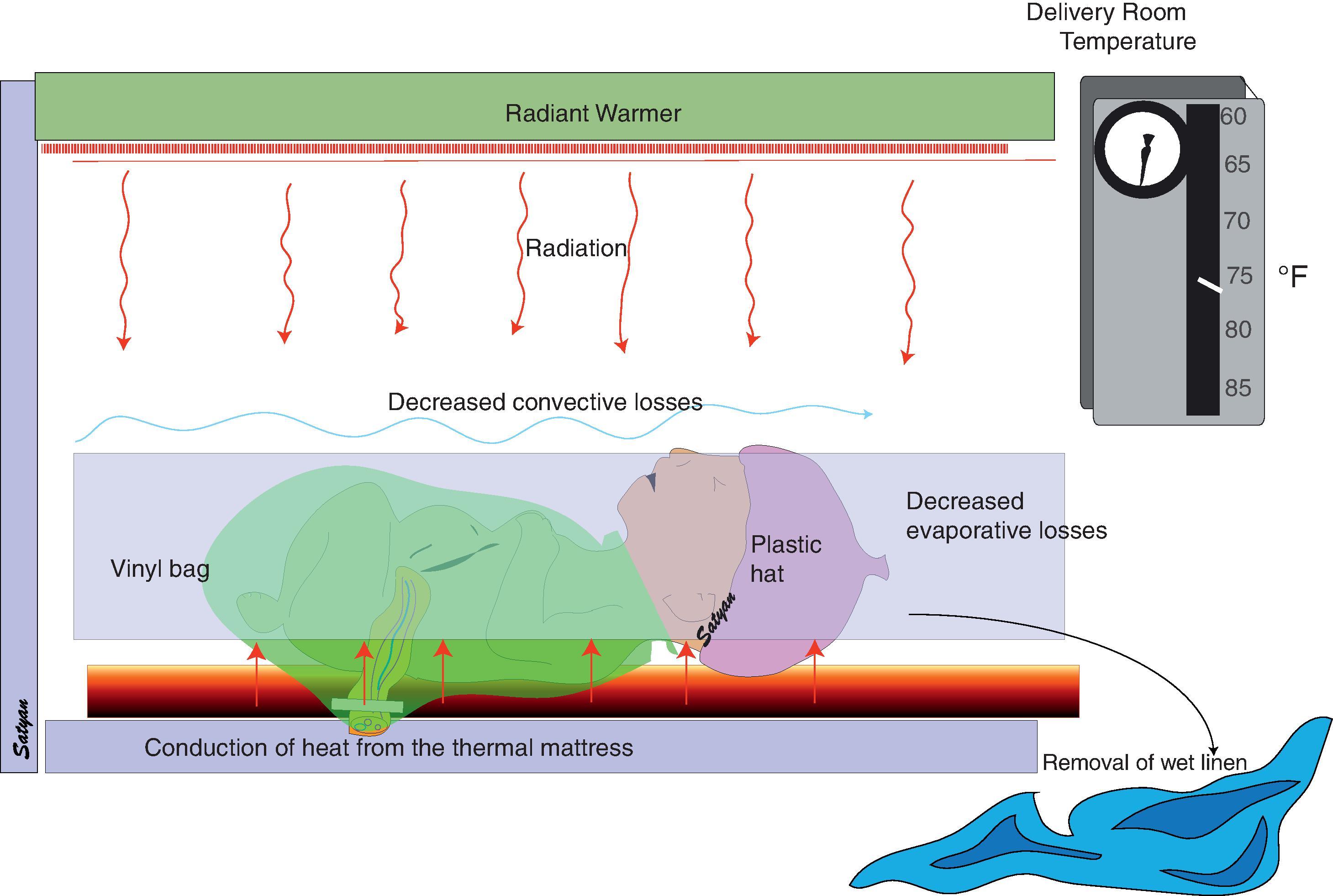
Additional measures should be taken if a preterm infant is expected. There was a 28% increase in mortality and 11% increase in late-onset sepsis for each 1°C decrease in temperature at neonatal intensive care unit admission in a 2007 analysis. Prior to the birth of a preterm infant, the temperature in the delivery and resuscitation room should be adjusted so it is 74°F to 77°F (24°C–25°C). There is also evidence that the use of plastic covers or bags and a combination of measures including the addition of plastic caps and thermal mattresses from resuscitation through admission prevents hypothermia in preterm infants and is the recommendation of the NRP.
The infant’s head and neck should be positioned such that the neck is slightly extended in the “sniffing” position. If the infant is with the mother, a trained observer should be able to see the infant’s nose and mouth, and the head should be turned to one side (see Fig. 8.3 ). The NRP continues to recommend suctioning the mouth before the nose ( M comes before N ) to ensure that oral secretions are not aspirated if the newborn gasps when the nose is suctioned if the infant appears to be having difficulty breathing due to secretions or is apneic, although there is a lack of supportive evidence.
If the infant remains apneic at 30 seconds of life, PPV should be initiated and heart rate should be monitored by either auscultation or placement of electrocardiogram (ECG) leads ; palpation of the umbilical cord may not be reliable, although assessment by auscultation may also be inaccurate. , At the time PPV is initiated, the recommendation by the NRP is to place a pulse oximeter and consider placing ECG leads for monitoring of the infant’s heart rate and oxygen saturation. However, ECG detects the heart rate faster than pulse oximetry, , and pulse oximetry may underestimate the heart rate. , A pulse oximeter can also be used to measure oxygen saturation of an infant who is breathing with a normal heart rate but remains cyanotic, because it has been shown that it is difficult for providers to make an assessment of color. Advantages and disadvantages of various modes of heart rate assessment in the delivery room are shown in Fig. 8.5 .
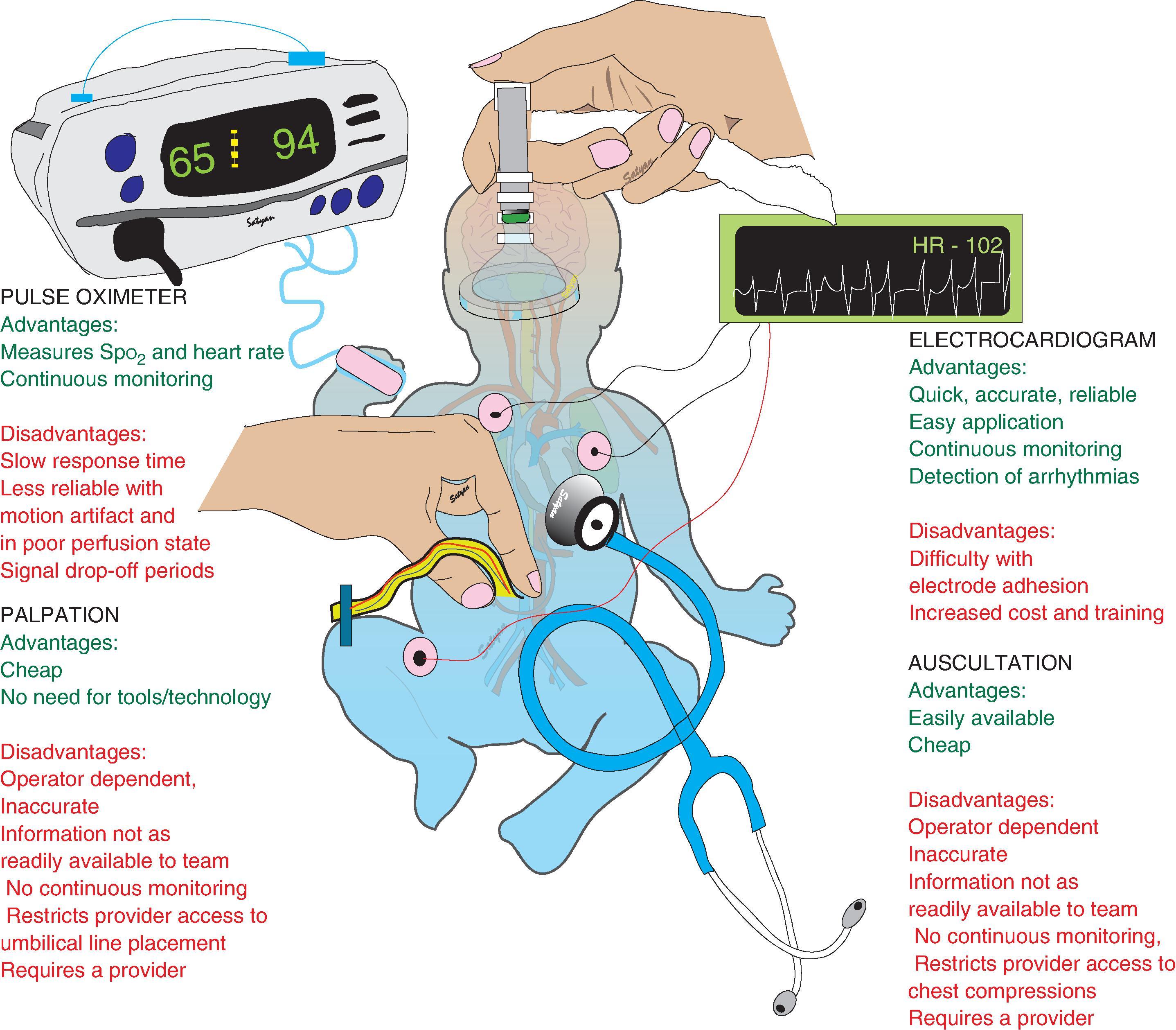
When the initial steps of resuscitation fail to produce spontaneous respiration, the infant is likely in secondary apnea and will need respiratory support (see Fig. 8.2 ). The provision of ventilation in the delivery room is crucial to a successful resuscitation of a depressed infant. It is through ventilation and establishment of FRC that both the respiratory and cardiovascular changes occur in the transition from fetal to neonatal life.
Become a Clinical Tree membership for Full access and enjoy Unlimited articles
If you are a member. Log in here